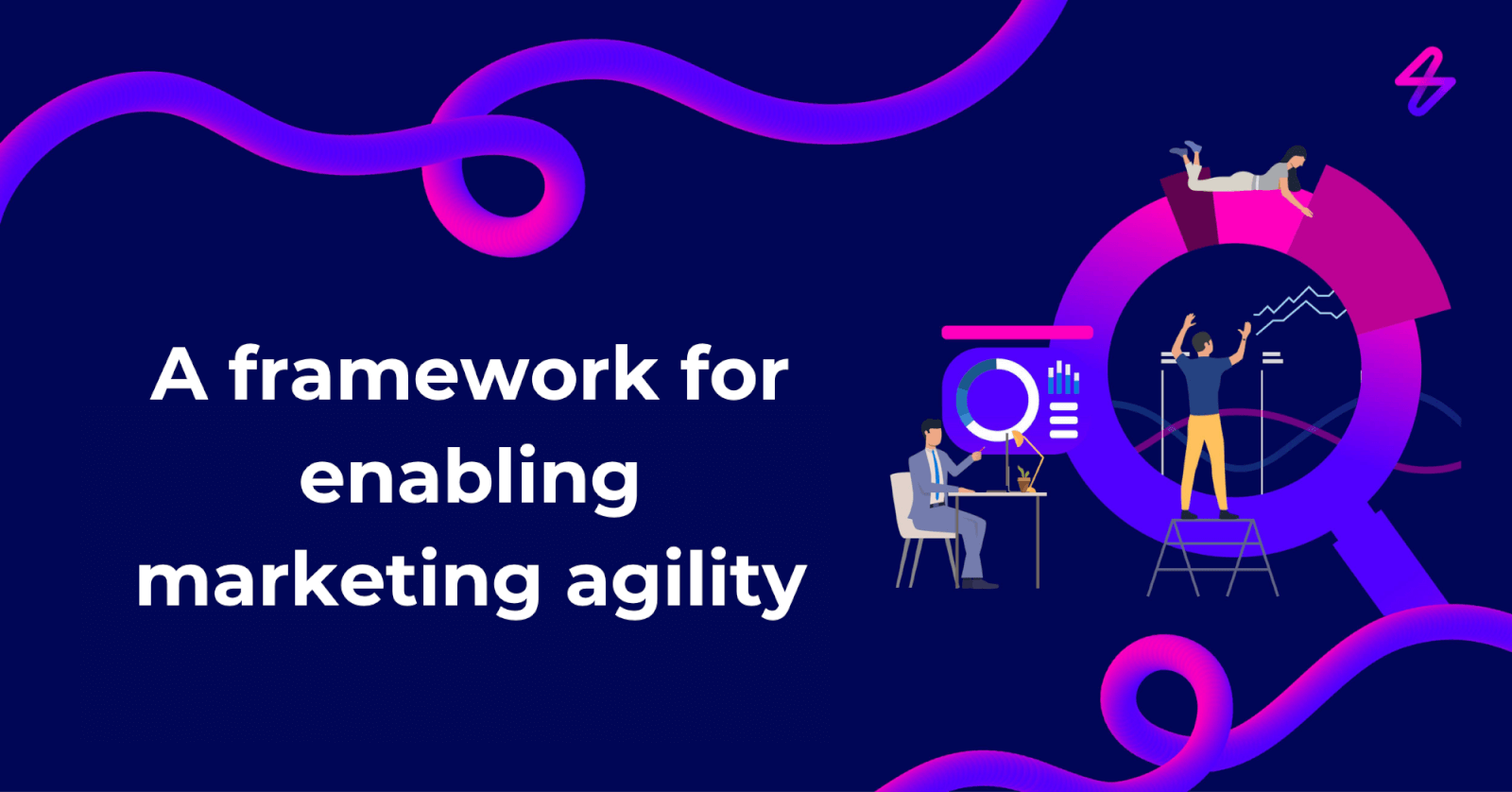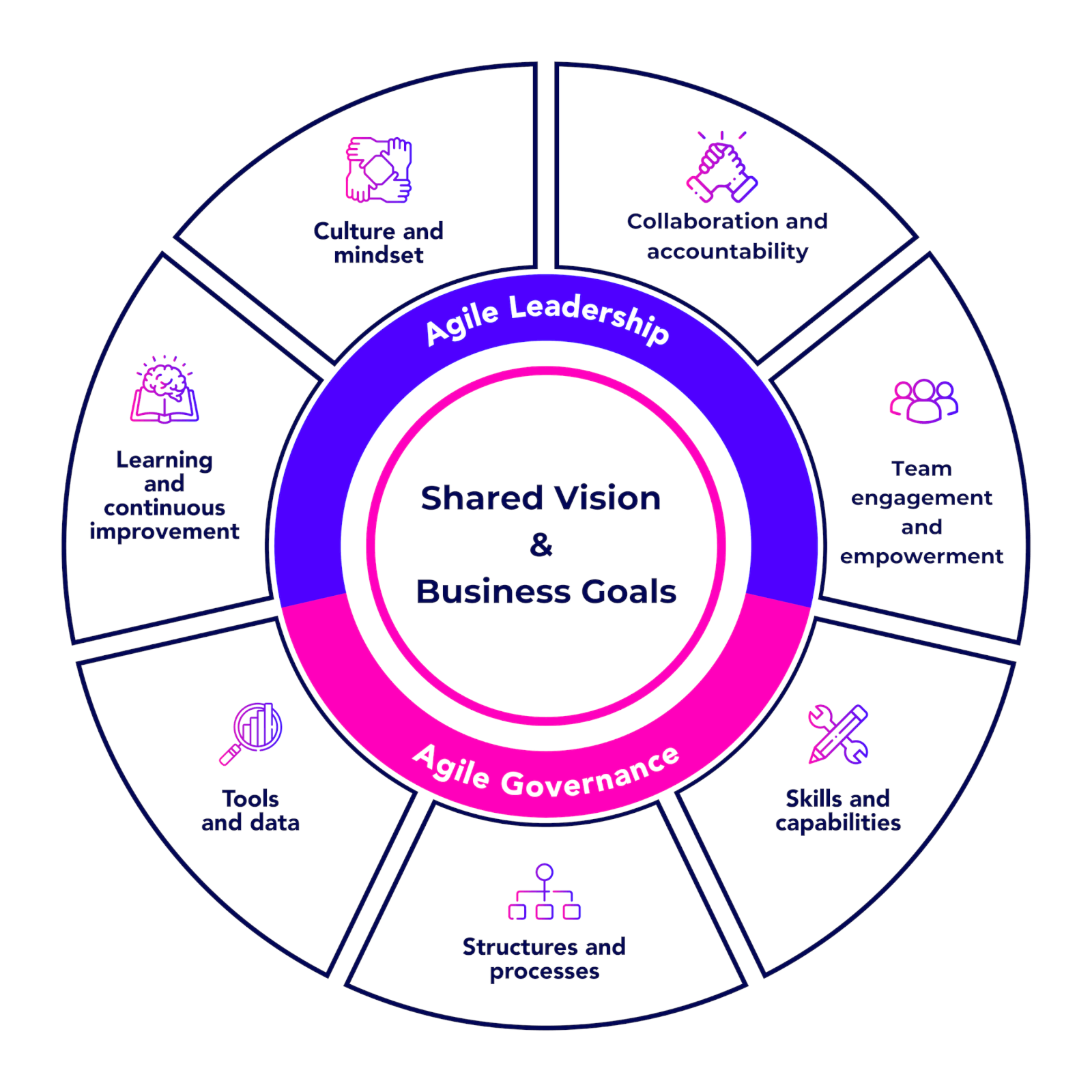How do you enable marketing agility in your organisation?
In this piece we dive into what makes up marketing agility and whilst it’s important to understand the key characteristics that make up marketing agility, making it happen in your organisation is a different matter.
Changing how your teams work is hard, and at times thankless. It’s no surprise that businesses often underestimate the amount of support and investment needed to drive change effectively. And if you’re nodding along to this then the following model may help you understand what you’re missing or need to focus more on to enable marketing agility to happen within your team or marketing organisation.
The framework for enabling marketing agility
The framework for enabling marketing agility has been created to help support marketing teams thrive and survive in an increasingly volatile, uncertain, and complex environment.
Shaped by classic models such as McKinsey 7s and modern marketing models by XYZ and our experiences enabling marketing agility with medium to large enterprise across tech, engineering, and professional services.
The framework
Shared vision & business goals
Organisational purpose is clear, compelling and guides decision making with the North Star embodied across the organisation and people sense and seize opportunities.
To put it simply, you need to make sure the shared vision is truly embedded, understood and lived across the organisation and that your vision guides all decision making.
Those means ensuring each business is clear on what these goals mean to them in their market, function or team and that performance management is aligned with these goals.
Agile Leadership
Agile leaders believe we all have the potential to deliver on a shared purpose. They develop individuals as leaders at all levels, showing direction and enabling action, acting in a selfless and supportive way to deliver against business objectives and customer and client satisfaction.
They advocate for being agile rather than just doing agile and do this by harnessing:
- Learning and continuous improvement
- Team engagement and accountability
- Agile culture and growth mindset
- Collaboration and empowerment
Culture and mindset
An agile culture provides an organisation with a set of core values, behaviours and practices that drives the businesses’ ability to succeed.
To truly drive an agile culture means promoting, encouraging, and rewarding the values, behaviours and practices that enable your teams to act with autonomy, apply a growth mindset and demonstrate a strong commitment to experimentation, learning, reflecting, and adapting.
Collaboration and empowerment
As leaders, you need to ensure that people have an appropriate level of autonomy to carry out their work, and that there are opportunities for teams to work together, collaborate, share learnings, and align themselves towards the common goal / strategic vision.
Continuous learning and improvement
Critical to marketing agility is that teams are constantly evolving and learning to deliver the best possible outcomes; through data driven build test learn loops to validate new ideas, optimise activity if appropriate or discontinue activities or initiatives if they are not aligned or helping the business reach its strategic goal.
Team engagement & accountability
Engagement and accountability are important. Your teams have to be bought into your vision if they are going to give you their best. Your employees need to have a deep sense of fulfilment, feel safe to push back and hold themselves and their colleagues accountable.
In addition, they need to be clear on their goals, with rewards aligned to this as well as clear lines of career development and progression to keep them engaged and retained.
Agile governance
Governance supports how businesses set and achieves its goals, how risk is managed and how it improves performance and is supported by structures and processes, skills and capability, tools, and data.
It can be defined as the structures and processes for decision-making and accountability.
Critical to agile governance is transparency of process and performance and doing so consistently across the marketing organisation. Supported by:
- Structures and processes
- Skills and capabilities
- Tools and data
Skills and capabilities
Driving agility means ensuring your teams have the right skills and capabilities to utilise new ways of working, channels or disciplines. That means matching the needs of the market and making sure you’re making skills and resource available in the right place at the right level. Providing opportunities for your teams to upskill, test and experiment to understand what works well and what doesn’t for your market context.
… become a data-driven marketer?
Structures and processes
As highlighted in agile governance this is focused on the structures and process for decision making and clear accountability. In the context of agile marketing things to think about here are regular planning, reviews, and retrospectives, KPI tracking that is visible to all and clear repeatable processes within your teams, and across your teams (depending on the structure of your marketing organisation).
Tools and data
Last but not least, agility can’t happen without the right data to support data-driven decision making. Centralised dashboards and insight that supports deep understanding of customers and audiences in real time, enabling transparency in reporting and performance and quick changes and flexing of resources as appropriate to increase the effectiveness of activity. But we aren’t just talking about data on what you’re doing, but also how you’re doing it. Using tools which allow you to have ‘work in progress limits’ and prioritise work will lead more things getting across the line – focus on the things which are delivering business results.
How agile is your marketing team?
Discover how agile your marketing organisation is with our agility calculator tool and determine whether you are surviving or thriving.


